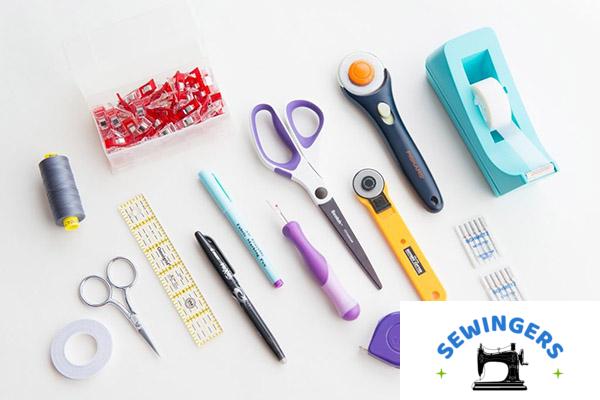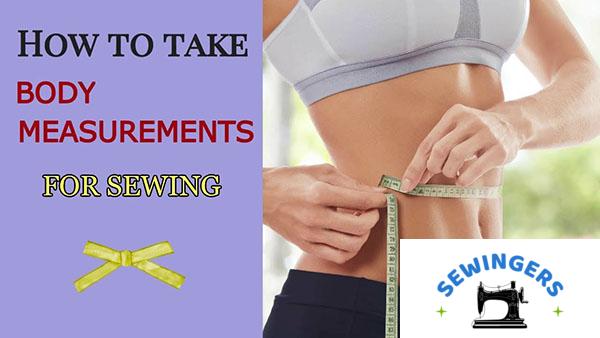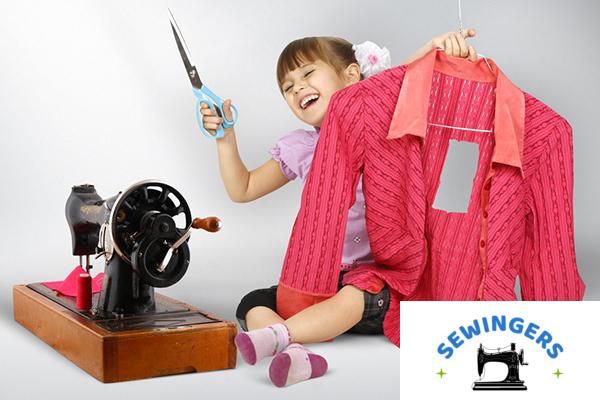Basic Sewing Supplies | What you need to get started

There’s something quietly satisfying about threading a needle, pressing the foot pedal, and hearing that first thunk-thunk-thunk of stitches pulling fabric together. It’s one of those sounds that takes me back—back to when sewing was mostly seen as a necessity, not the creative outlet or sustainable statement it’s become today. But here’s the thing: lately, more and more people are dusting off old machines (or grabbing starter sewing kits off Etsy) and finally giving this hobby a shot. And honestly? I think it’s about time.
In the last few years, I’ve seen a real shift—especially here in the U.S.—toward all things DIY. Whether it’s the explosion of the craft movement, the rise of visible mending on Instagram, or just folks trying to fix a ripped hem instead of tossing it, sewing is having a moment again. People are craving slower, hands-on projects. They want to create, repair, reuse. And sewing? It hits all of that. It’s budget-friendly, endlessly customizable, and yeah—there is a bit of a learning curve, but nothing you can’t handle with the right tools and a little patience.
So, if you’ve been wondering how to start sewing—or just need a beginner sewing guide that doesn’t overwhelm you—stick around. I’ll walk you through the basics, share what’s worked for me (and what hasn’t), and help you build a solid, stress-free foundation. Let’s dive in.
Contents
Must-Have Tools for Hand Sewing Beginners
When I first started sewing by hand (long before I could afford a machine), I assumed I just needed a needle and some thread. And while technically that can get the job done, what I’ve learned over the years is that having the right hand sewing tools—just the basics—makes a huge difference, especially when you’re just starting out.
Needles, for example, aren’t one-size-fits-all. There are sharp needles, embroidery needles, quilting needles—and each has a job. For basic repairs or hemming, a standard sharps needle in size 7 or 8 works great. Pair that with thread that matches the weight of your fabric (lighter for silks, heavier for denim), and you’re off to a solid start.
Fabric scissors are another must. Not the dull kitchen scissors you’ve been using to open Amazon boxes (guilty). A sharp pair of shears changes everything. And trust me, a seam ripper might not sound essential, but you’ll reach for it more than you expect—especially during those “well, that didn’t work” moments.
Now, I didn’t appreciate the value of a thimble until about my third sore finger in a week. If you’re working with thick fabric or layers, save yourself the pain—get one early. It’s such a small tool, but it makes sewing by hand way more comfortable.
Honestly, you don’t need a giant kit to get going. A small pouch with these five essentials—needle, thread, scissors, seam ripper, and a thimble—is more than enough to tackle most hand-sewing projects. Keep it portable, keep it simple. You’ll build from there.

Choosing Your First Sewing Machine
Buying your first sewing machine feels a bit like picking out your first car—it’s exciting, a little intimidating, and honestly? It’s easy to get overwhelmed by all the bells and whistles you don’t actually need. What I’ve found, after years of teaching beginners and repairing more than a few “too-fancy-too-fast” machines, is this: start simple. Solid and simple wins every time.
For beginner models, Singer and Brother both make reliable, affordable machines you’ll still love a few years down the road. The Brother CS6000i is a classic pick—lightweight, intuitive, and packed with just enough features to grow into. Singer’s Heavy Duty 4423 is another go-to, especially if you’re planning to sew denim or thicker fabrics from the jump.
Now, don’t worry too much about having 50+ stitch options (you’ll mostly use two, maybe three). But do check for must-haves: an easy bobbin system, adjustable stitch length, a responsive foot pedal, and—if you can swing it—a decent U.S. warranty. Oh, and make sure the presser foot is easy to swap. That’s a small detail that’ll save you a lot of frustration later.
Must-Have Notions and Accessories for Your Sewing Setup
You can have the best sewing machine in the world, but if you don’t have the right notions on hand? You’ll be up a creek halfway through your first project. I learned that the hard way—back in the day, I tried hemming a pair of jeans with no pins, no chalk, and a half-dried-up fabric marker. It wasn’t pretty.
At the very least, you’ll want a good measuring tape (flexible, not stiff), some tailor’s chalk or a washable marking pen, and a solid stash of straight pins—glass head pins are my go-to because they don’t melt under the iron. Pin cushions (the classic tomato one works just fine) keep things from ending up in the carpet, which my feet appreciate. And if you’re cutting more than just quilting cotton? Go ahead and grab a rotary cutter with a self-healing mat. Trust me—it’s one of those upgrades that feels unnecessary at first… until you use it once.
Most of these basics are easy to find at Joann’s or Walmart—Dritz, Singer, and Fiskars are brands I’ve used and trusted over the years. The point is, don’t overthink it. Stock your space with the right tools now, and you’ll spend way less time fixing avoidable mistakes later.
Choosing the Right Fabric and Thread
If there’s one thing I wish someone had told me when I first started sewing, it’s this: not all fabric is friendly. Some of it slips, stretches, frays, curls—makes you want to quit before you’ve even finished your first project. That’s why I always steer beginners toward good ol’ woven cotton—especially quilting cotton or muslin. It’s stable, holds its shape, and behaves (most of the time).
Muslin is great for practicing stitches or testing out a pattern, and cotton comes in endless prints, which makes it a little more exciting when you’re learning. Polyester blends can work too, but they’re a bit more slippery—so I’d wait on those. And whatever you choose, pay attention to fabric weight. Too thick (like upholstery) or too thin (like chiffon), and it’s just not worth the headache early on.
Now, matching your thread to your fabric is key. Color-wise, go just a shade darker than your fabric—it’ll blend better than something too light. For most projects, an all-purpose polyester thread works fine. You can find good options at Joann’s or even Walmart (Coats & Clark is reliable).
Storage and Organization Tips for a Small Sewing Space
Let me tell you—nothing slows down a project faster than not being able to find your seam ripper. I’ve spent more time than I care to admit digging through a messy drawer for that one spool of navy thread I swear I had. Over the years, I’ve learned (sometimes the hard way) that staying organized isn’t just about aesthetics—it’s about actually enjoying the process.
If you’re sewing in a tight space (a kitchen table, a corner of the guest room, a hallway nook—I’ve been there), modular storage is your best friend. A clear storage bin with dividers works wonders for keeping your tools visible and within arm’s reach. I’ve also used a cheap drawer organizer from Walmart to hold bobbins, chalk, and spare needles—it’s not fancy, but it does the trick.
Now, here’s what changed the game for me: a pegboard. Yep, straight out of a garage. Mount it to a wall, hang your scissors, rotary cutter, measuring tape—it frees up precious drawer space and looks kind of satisfying once it’s all set up.
My advice? Keep it simple. One good sewing basket, a bin or two, and a plan for where things go when you’re done. It’ll save your sanity when the creative chaos hits.
Where to Buy Sewing Supplies in the U.S.
Here’s something I hear a lot from new sewists: “Where do I even buy all this stuff?” And honestly, I get it. Years ago, we had a local fabric shop where the owner knew every bolt by name—and if you needed thread, she’d match it by holding it up to the sunlight (true story). These days, though? Most folks are toggling between online carts and the fluorescent aisles of big-box stores.
If you’re just starting out, the U.S. has plenty of beginner-friendly options. Joann Fabric is probably the most well-rounded—it’s got fabric, notions, machines, and those weekly coupons we all hoard. Walmart is convenient and surprisingly decent for basics, especially if you need affordable thread or a quick starter kit. Amazon is a mixed bag—I’ve used it for bulk zippers or specialty tools, but I always double-check reviews (some of the off-brand stuff? Eh… not great). And then there’s the fun side of shopping: places like Mood Fabrics or local shops where you can touch everything before you buy.
You see, where you shop kind of depends on how you like to sew. So let’s break down the pros and cons and figure out what works best for your setup.
Bonus: Budgeting Your First Sewing Kit
If you’re anything like I was starting out, you walk into the craft store with wide eyes and no clue what’s actually essential. You grab a few spools of thread, maybe a cute pin cushion, and suddenly—boom—$80 gone. And half of it? Stuff you won’t use for six months. What I’ve found (after building way too many “beginner kits” for friends and classes) is that you can absolutely start strong without overspending—you just need to know where to put your dollars.
With $50, stick to the non-negotiables: sharp fabric scissors, a set of hand needles, pins, a seam ripper, a measuring tape, and all-purpose thread. Stores like Walmart or Joann’s will usually carry value kits with most of that bundled.
Bump it to $100, and you can add a basic handheld machine or a more complete set of notions—maybe even a small rotary cutter and mat if you’re feeling ambitious.
At $200, you’re looking at your first reliable sewing machine (like a beginner model from Brother or Singer), plus everything above. That’s honestly a solid setup you’ll use for years.
Start small, build as you go—and don’t fall for the “you need everything now” trap. You don’t.





